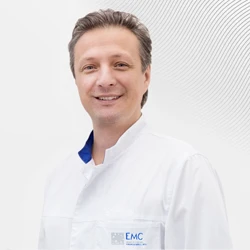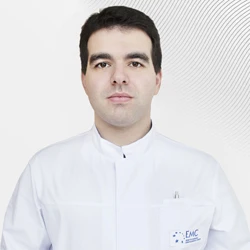Endoprosthesis for coxarthrosis
Coxarthrosis is a disease of the hip joint that is associated with the destruction of articular cartilage and subsequent deformation of bone tissue. According to statistics, one in ten people over the age of 45 suffers from this pathology2. Almost the only effective method of its treatment in the late stages is endoprosthesis, which is the complete or partial replacement of the damaged joint with an artificial one.
Causes of the disease
The hip joint is exposed to high loads throughout its life, therefore it is more often injured and wears out faster.
Coxarthrosis begins with metabolic disorders inside the joint. Over time, this leads to cartilage destruction, bone deformity, abnormal bone growth, inflammation, and loss of normal joint function .
The risk of coxarthrosis is higher in the elderly, after injuries, with high loads on the joints associated with obesity, sports, or heavy physical labor. Genetic predisposition and various chronic diseases can also contribute to the development of pathology.
Symptoms
Patients with coxarthrosis usually complain of periodic or persistent pain and stiffness in the affected joint. Stiffness increases after a night's sleep or when getting up after sitting for a long time and usually resolves within 30 minutes. The development of the disease leads to a decrease in physical activity and quality of life, which worsens not only the physical, but also the psychological state of the patient.
Stages of development of osteoarthritis of TB
Experts distinguish three degrees of the disease:
-
With grade 1 coxarthrosis, there are periodic pains in the groin area, which usually occur after physical exertion, prolonged walking, and active movements in the joint. In this case, coxarthrosis can only be diagnosed with X-ray examination. The images show slight marginal bone growths.
-
With grade 2 coxarthrosis, the pain becomes more intense, occurs even with a light load, and can spread to the inner surface of the thigh. As a result, joint mobility is limited and muscle strength is reduced.
-
With 3 degrees of osteoarthritis of the TBS, pain at rest and against a background of minor stress becomes constant. Often, patients are forced to use a cane. Due to the misalignment of the pelvis and spine, lameness may occur. In general, motor activity is significantly reduced.
Diagnosis of coxarthrosis
The doctor makes a diagnosis of coxarthrosis based on medical history, physical examination, and X-ray examination.
X-rays determine the severity of hip joint injuries, osteophytes (bone growths) and narrowing of the articular fissure (fluid-filled cavity inside the joint) are detected.
With the help of magnetic resonance imaging, a more complete picture of the joint lesion is obtained - changes in cartilage, acetabulum, bone and synovial membrane are detected. An MRI scan is also prescribed if a tumor or infection is suspected.
Treatment of the disease
Coxarthrosis treatment tactics are selected by the attending physician depending on the stage and rate of disease progression, age andthe general condition of the patient, the presence of concomitant pathologies and a number of other factors.
Conservative therapy
Drug and non-drug therapy are used in the treatment of coxarthrosis. The main tasks are to eliminate or reduce pain, restore the patient's former mobility, and preserve muscle function. The following drugs are used in the treatment of coxarthrosis:
-
non—hormonal anti-inflammatory drugs - for relief of pain and inflammation;
-
Vasodilators— to improve blood supply to joints;
-
chondroprotectors— to restore the normal composition of cartilage;
-
Ointments and compresses with medicines are used to improve blood circulation and relieve muscle spasms in the joint area.
The effect of using medications is enhanced with the help of physiotherapy courses (electrotherapy, magnetic therapy, ultrasound therapy), massage and physical therapy.
A patient with a high body mass index is recommended to lose weight. During periods of exacerbation, vertical loads are limited, jumping, lifting weights, and prolonged standing are excluded. They are being replaced by exercise bike classes and swimming.
Conservative treatment is carried out under the supervision of a rheumatologist and can be effective for grade 1 and 2 coxarthrosis.
Injections of any drugs into joints are undesirable due to the high risk of side effects.
Hip arthrosis surgery
In most cases, surgical treatment is the replacement of the entire damaged joint or one part of it (femoral head) with an endoprosthesis. In the first case, the structure is more durable, but the operation is considered more complex. In the second case, the implant is not designed for greater motor activity, but its installation is less traumatic. Partial arthroplasty is usually offered to elderly patients.
EMC surgeons use the most gentle hip replacement methods in accordance with European and North American protocols:
-
Intravenous general anesthesia, spinal or epidural anesthesia for pain relief;
-
small incisions (6-8cm) to reduce muscle damage, blood loss, and postoperative scars.
The duration of the operation is from 30 to 60 minutes.
Previously used osteotomy (artificial fracture of the femur in order to eliminate deformity of the femoral bone) and arthrodesis (immobilization of the diseased joint) are considered obsolete. These techniques are only suitable in cases where endoprosthetics are not possible.
Indications
Hip replacement is recommended in the following cases:
-
Conservative therapy does not bring relief of symptoms;
-
Osteoarthritis of TBS is progressing rapidly;
-
Grade 3 coxarthrosis with constant intense pain and significant limitation of mobility.
Contraindications
Endoprosthesis is contraindicated if infections have been detected in the hip and other joints, as well as in the surrounding soft tissues. Surgery is not performed in patients with any diseases in the acute stage, with grade 3 obesity (BMI — 40 kg/m 2 and higher).
Rehabilitation
Rapid rehabilitation is one of the advantages of hip replacement. Modern technologies allow the patient to get up and move around with the support of crutches or a walker the very next day after surgery. After 4-6 weeks, the patient returns to his usual lifestyle.
Questions and answers
What are the advantages of hip replacement in EMC?
-
Orthopedic surgeons at the European Medical Center have the latest techniques and protocols for endoprosthesis, are constantly improving their skills, and have performed more than 1,500 operations since 2009.
-
Specialists have at their disposal modern diagnostic methods and a wide range of artificial joints made of metal, plastic and ceramics from world leaders in the production of endoprostheses: ZIMMER, Smith&Nephew, DePuy, Aesculap. Accurate diagnosis and individual selection of implants reduces the risk of complications and accelerates rehabilitation.
-
The therapist prepares patients for surgery and monitors their condition during the recovery phase.
-
Age is not a contraindication— EMC specialists have extensive experience in successfully working with elderly patients.
-
Rehabilitation treatment is carried out by doctors of the rehabilitation department, which reduces the time spent in the hospital to 5-7 days.
To make an appointment for a hip replacement consultation, please call around the clock by phone in Moscow +7 495 933-66-55.
How long will the endoprosthesis last?
The service life of an endoprosthesis depends on many factors. There have been cases when an artificial joint has remained in working condition for more than 40 years. According to statistics, one of the four implants fails or is replaced for other reasons after 15-20 years, and one of the two implants fails after 25 years after installation. It is believed that in sedentary patients over the age of 60, a hip prosthesis will last a lifetime, while younger and more active patients are more likely to be replaced.
- Fan Z, Yan L, Liu H, Li X, Fan K, Liu Q, Li JJ, Wang B. The prevalence of hip osteoarthritis: a systematic review and meta-analysis. Arthritis Res Ther. 2023 Mar 29;25(1):51.
- Katz JN, Arant KR, Loeser RF. Diagnosis and Treatment of Hip and Knee Osteoarthritis: A Review. JAMA. 2021 Feb 9;325(6):568-578.
- Günther KP, Deckert S, Lützner C, Lange T, Schmitt J, Postler A; Collaborators. Total Hip Replacement for Osteoarthritis-Evidence-Based and Patient-Oriented Indications. Dtsch Arztebl Int. 2021 Oct 29;118(43):730-736.
- Evans JT, Evans JP, Walker RW, Blom AW, Whitehouse MR, Sayers A. How long does a hip replacement last? A systematic review and meta-analysis of case series and national registry reports with more than 15 years of follow-up. Lancet. 2019 Feb 16;393(10172):647-654.
Make an appointment for a consultation and we will contact you for more details
Why the EMC
The first and only clinic in Russia, created in the image of the world's leading clinics
EMC is a multidisciplinary center offering patients a high level of medical services and a personalized approach
Worldwide recognition and awards
 Learn more
Learn more
Worldwide recognition and awards
 Certificates and licenses
Certificates and licenses












.webp)




.webp)

